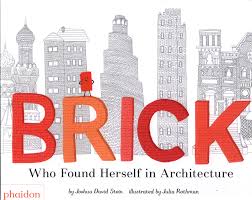Math and Children’s Books: Fabulous, Fun and Fantastic! Part 2
The two books I am going to introduce to you today are quite different from one another. The first is a book titled BRICK: Who Found Herself in Architecture, written by Joshua David Stein and illustrated by Julia Rothman.

This is a delightfully illustrated book that centers around a small red brick who grows up and tries to find her place in the world. She travels to lands near and far searching for a structure that she fits into. She visits castles and famous buildings and walls, searching for the place that feels like home. I won’t spoil the book and tell you where she ends up, but it is a lovely story about belonging and life. It is not necessarily obvious where the math come into play in this book, but it jumped out at me when mathematical vocabulary was used to describe the brick (small), the buildings (tall) and other math vocabulary words such as same, different, wide, etc. In addition, the illustrations lend themselves to talking about similarities and differences, size, shape and number.
This is a deep and thoughtful book that is perfect for a quiet time during the day or evening when you and your child(ren) have time to really examine the illustrations and talk not only about mathematical concepts, but about doing great things, being brave and belonging.
The second book is a classic children’s book written by Bill Martin and illustrated by Eric Carle called Polar Bear Polar Bear, What Do You Hear? This book is a delightful companion to their book, Brown Bear, Brown Bear, What Do You See?

Polar Bear Polar Bear, What Do You Hear? is a classic pattern book. A pattern book is typically a book with few sentences on each page that has a very repetitive and predictable sequence to it. This allows children to be able to anticipate what the next word of a sentence is because it is repeated throughout the book. The book starts with a Polar Bear who is asked “Polar Bear, Polar Bear, what do you hear?” The polar bear then states that he hears a “lion roaring in my ear.” The lion is then asked what he hears and he tells us…. and so on. Children easily begin to predict that each of the animals will be asked what they hear…using the same simple words each time.
How does this help children with mathematical thinking? The answer is PATTERNS! The repetitive nature and predictability of the story helps children begin to acquire the important skills of predicting and hypothesizing. To start to predict what comes next is an important math skill. Recognizing patterns provides the foundation for being able to make predictions based on observation of the repetition of patterns and, as children grow in their mathematical skills, later make predictions based on data.
I hope you will enjoy reading these two books to your child(ren) and that you will continue to find books that foster mathematical thinking and skills. Please share your favorite books with us in the comments and tell us how they help children develop mathematical skills!
In what ways can you point out the difference in books to children in a physical way?
I agree in the pattern use as a good math tool for prediction. The beautiful thing is that this also provides groundwork for rhyming in literacy.